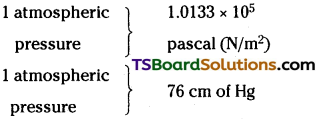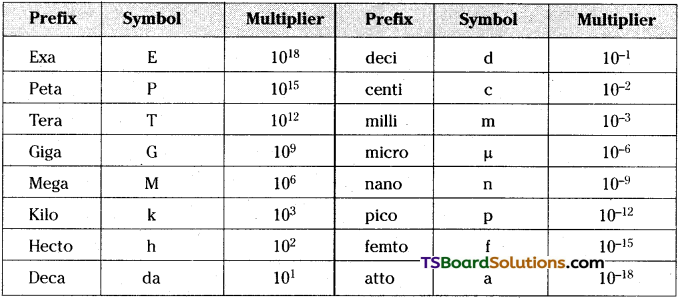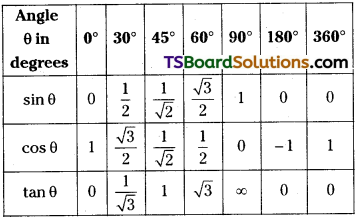Telangana TSBIE TS Inter 1st Year Physics Study Material 2nd Lesson Units and Measurements Textbook Questions and Answers.
TS Inter 1st Year Physics Study Material 2nd Lesson Units and Measurements
Very Short Answer Type Questions
Question 1.
Distinguish between accuracy and precision. [AP Mar. ’15, ’16, May 16, 13, June 15; TS May ’18, Mar. ’15]
Answer:
Accuracy :
It indicates the closeness of a measurement to the true value of given quantity.
→ If the measurement is nearer to true value then accuracy is more.
Precision :
Precision of a measuring instrument depends on the limit (or) resolution of the quantity measured with that instrument.
→ If the least measurable value is less, then precision is more for that instrument.
Question 2.
What are the different types of errors that can occur in a measurement?
Answer:
Types of errors 1) Systematic errors and 2) Random errors.
Systematic errors are again divided into 1) Imperfectional errors 2) Environmental errors and 3) Personal errors.
Question 3.
How can systematic errors be minimised or eliminated? [AP May ’17; TS Mar. ’17; AP May ’17; TS Mar. ’17]
Answer:
Systematic errors can be minimised
- by improving experimental techniques,
- by selecting better instruments,
- by taking mean value of number of readings and
- by removing personal errors as far as possible.
Question 4.
Illustrate how the result of a measurement is to be reported indicating the error involved.
Answer:
Suppose length of an object is measured with a metre rod with least count equal to 0.1 cm. If the measured length is 62.5 cm, it has to be recorded as (62.5 ± 0.1) cm, stating the limits of error. Similarly, suppose time period of a pendulum is measured to be 2.0 sec, using a stopwatch of least count 0.1 sec, it has to be recorded as (2.0 ± 0.1) sec. It indicates that time period is in the range of 1.9 sec and 2.1 sec.

Question 5.
What are significant figures and what do they represent when reporting the result of a measurement? [TS Mar. ’18]
Answer:
Significant figures represents all practically measured digits plus one uncertain digit at the end.
When a result is reported in this way we can know up to what extent the value is reliable and also the amount of uncertainty in that reported value.
Question 6.
Distinguish between fundamental units and derived units. [TS Mar. ’16 ; AP May ’14]
Answer:
1) Fundamental units are used to measure fundamental quantities. Derived units are used to measure derived quantities.
2) Fundamental units are independent. Derived units are obtained by the combination of Fundamental units.
Ex: Metre is fundamental unit of length L’. metre/sec is derived unit of velocity which is a combination of fundamental unit metre and second.
Question 7.
Why do we have different units for the same physical quantity? [TS May ’16. June ’15]
Answer:
To measure the same physical quantity we have different units by keeping magnitude of the quantity to be measured.
Example:
- The measure astronomical distances we will use light year.
1 light year = 9.468 × 1015m. - To measure atomic distances we will use Angstrom A (or) Fermi.
Question 8.
What is dimensional analysis?
Answer:
Dimensional analysis is a tool to check the relations among physical quantities by using their dimensions.
Dimensional analysis is generally used to check the correctness of derived equations.
Question 9.
How many orders of magnitude greater is the radius of the atom as compared to that of the nucleus?
Answer:
Size of atom = 10-10 m,
Size of atomic nucleus = 10-14m.
Size of atom ÷ size of nucleus is \(\frac{10^{-10}}{10^{-14}}\) = 104
∴ Size of atom is 104 times greater than size of nucleus.
Question 10.
Express unified atomic mass unit in kg. [TS Mar. ’19]
Answer:
By definition,
1 a.m.u. = \(\frac{1}{12}\) × mass of an atom of 126C

Short Answer Questions
Question 1.
The vernier scale of an instrument has 50 divisions which coincide with 49 main scale divisions. If each main scale division is 0.5 mm, then using this instrument what would be the minimum inaccuracy in the measurement of distance?
Answer:
Least count of Vernier Callipers = 1 MSD – 1 VSD
∴ L.C. = 1 MSD – \(\frac{49}{50}\)MSD = \(\frac{1}{50}\)MSD
= \(\frac{1}{50}\) × 0.5 = 0.01 m.m
Question 2.
In a system of units, the unit of force is 100N, unit of length is 10m and the unit of time is 100s. What is the unit of mass in this system?
Answer:
Here, F = MLT-2 = 100 N → (1) ;
L = 10 m ; T = 100s
∴ From equation (1)
M × (10) × (100)-2 = 100 ⇒ M × 10-3 = 100
⇒ M = \(\frac{100}{10^{-3}}\) ⇒ M = 105 kg.

Question 3.
The distance of a galaxy from Earth is of the order of 1025m. Calculate the order of magnitude of the time taken by light to reach us from the galaxy.
Answer:
Size of galaxy = 1025m,
Velocity of light, c = 3 × 108 ms-1
Time taken by light to reach earth,

While calculating the order of magnitude we will consider the powers of Ten only.
So order of magnitude of time taken by light to reach earth from galaxy is 1017 seconds.
Question 4.
The Earth-Moon distance is about 60 Earth radius. What will be the approximate diameter of the Earth as seen from the Moon?
Answer:
Earth moon distance, D = 60r.
Diameter of earth, b = 2r
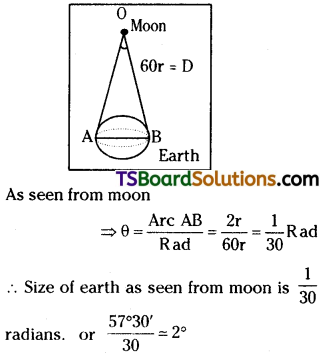
Question 5.
Three measurements of the time for 20 oscillations of a pendulum give t1 = 39.6 s, t2 = 39.9 s and t3 = 39.5 s. What is the precision in the measurements? What is the accuracy of the measurements?
Answer:
Precision is the least measurable value with that instrument in our case precision is ±0.1 sec.
Calculation of accuracy :
Average value of measurements

Error in each measurement =
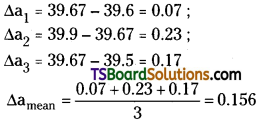
Precision ± 1 sec. In these measurements only two significant figures are believable. 3rd one is uncertain.
Adjustment of ∆amean upto given significant figure = 0.156 adjusted to 0.2.
So our value is accurate upto ±0.2
So our result is 39.67 ± 0.2, when significant figures taken into account it is 39.7 ± 0.2 sec.
Question 6.
1 calorie = 4.2 J where 1J = 1 kg m²s-2. Suppose we employ a system of units in which the unit of mass is α kg, the unit of length is β m and the unit of time γ s, show that a calorie has a magnitude 4.2 α-1 β-2 γ² in the new system.
Answer:
Here, 1 calorie = 4.2 J = 4.2 kg m² / s² → (1)
As new unit of mass = α kg
∴ 1 kg = \(\frac{1}{\alpha}\) new unit of mass
⇒ α-1 new unit of mass
Similarly lm = β-1 new unit of length and 1s = γ-1 new unit of time
Putting these values in (1) we get
1 calorie = 4.2 (α-1 new unit of mass) (β-1 new unit of length)² (γ-1 new unit of time)-2
= 4.2 α-1 β-2 γ² new unit of energy, which was proved.
Question 7.
A new unit of length is chosen so that the speed of light in vacuum is 1 ms-2. If light takes 8 min and 20s to cover this distance, what is the distance between the Sun and Earth in terms of the new unit?
Answer:
Given that velocity of light in vacuum,
c = 1 new unit of length s-1
Time taken by light of Sun to reach Earth, t = 8 min 20s = 8 × 60 + 20 = 500 s
∴ Distance between the Sun and Earth, x = c × t
= 1 new unit of length s-1 × 500s
= 500 new units of length.

Question 8.
A student measures the thickness of a human hair using a microscope of magnification 100. He makes 20 observations and finds that the average thickness (as viewed in the microscope) is 3.5 mm. What is the estimate of the thickness of hair?
Answer:

∴ Thickness of hair is 0.035 mm
Question 9.
A physical quantity X is related to four mea-surable quantities a, b, c and d as follows:
X = a²b³C5/2d-2
The percentage error in the measurement of a, b, c and d are 1%, 2%, 3% and 4% respectively. What is the percentage error in X?
Answer:
Here, X = a²b³C5/2d-2

The percentage error in X is ± 23.5 %
Question 10.
The velocity of a body is given by v = At² + Bt + C. If v and t are expressed in SI, what are the units of A, B and C?
Answer:
From principle of Homogeneity the terms At², Bt and C must have same dimensional formula of velocity ‘v’.
v = Velocity = LT-1 ⇒ CT-1 = A [T²]
∴ A = \(\frac{LT^{-1}}{T^2}\) = LT-3 . So unit of A is m/sec³
LT-1 = BT ⇒ B = LT-2 So unit of B is m/sec²
LT-1 = C So unit of C is m/sec.
Dimensional formulae of physical quantities
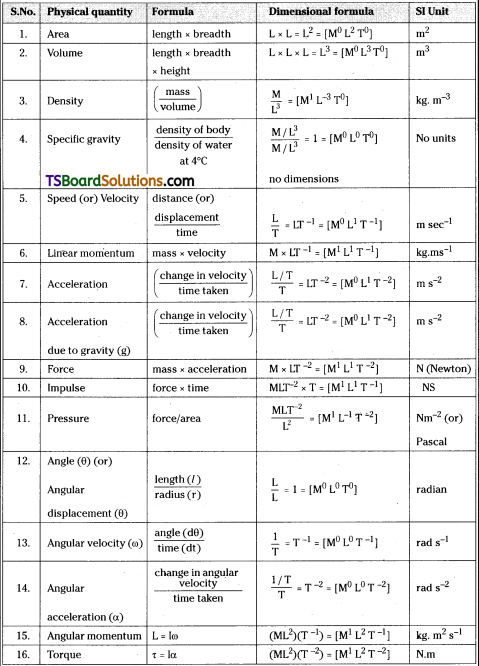
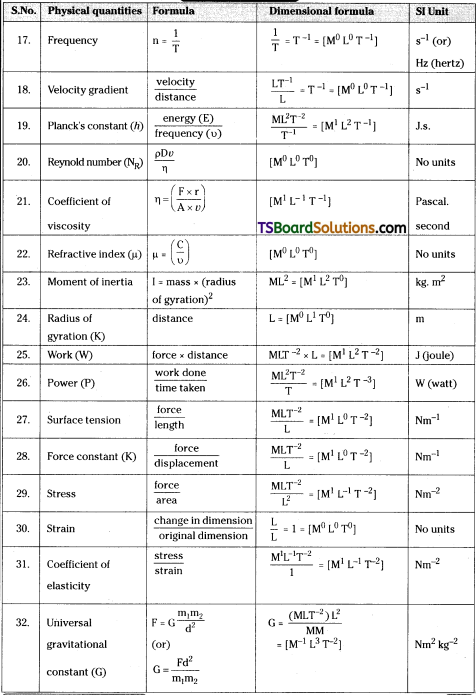

Problems
Question 1.
In the expression P = El² m-5 G-2 the quantities E, l, m and G denote energy, angular momentum, mass and gravitational constant respectively. Show that P is a dimensionless, quantity.
Solution:
Here, P = El² m-5 G-2
Here,
I = energy,
l = angular momentum
m = mass
G = gravitational constant
= [M L²T-2][ML²T-1]² [M]-5 [M-1L³T-2]-2
= M1+2+5+2 L2+4-6 T-2-2+4
P = [M° L° T°]
Hence, P is a dimensionless quantity.

Question 2.
If the velocity of light c, Planck’s constant, h and the gravitational constant G are taken as fundamental quantities; then express mass, length and time in terms of dimensions of these quantities.
Solution:
Here, c = [L T-1] ; h = [ML²T-1]
G = [M-1L³T-2]
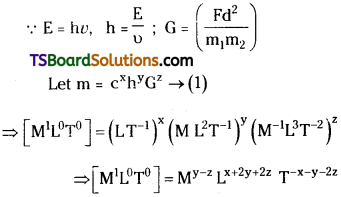
Applying the principle of homogeneity of dimensions, we get
y – z = 1 → (2) ; x + 2y + 3z = 0 → (3) ; – x – y – 2z = 0 → (4)
Adding eq. (2), eq. (3) and eq. (4),
2y – 1 ⇒ y = \(\frac{1}{2}\)
∴ From eq. (2) z = y – 1 = \(\frac{1}{2}\) – 1 = \(\frac{-1}{2}\)
From eq. (4) x = -y – 2z = \(\frac{-1}{2}\) + 1 = \(\frac{1}{2}\)
Substituting the values of x, y & z in eq. (1), we get
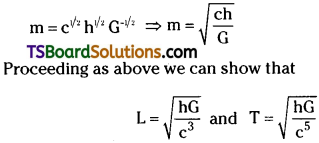
Question 3.
An artificial satellite is revolving around a planet of mass M and radius R, in a circular orbit of radius r. Using dimensional analysis show that the period of the satellite.
T = \(\frac{k}{R} \sqrt{\frac{r^3}{g}}\)
where k is a dimensionless constant and g is acceleration due to gravity.
Solution:
Given that
T² ∝ r³ or T ∝ r3/2 Also T is a function of g and R
Let T ∝ r3/2 ga Rb where a, b are the dimen¬sions of g and R.
(or) T = k r3/2 ga Rb → (1)
where k is dimensionless constant of proportionality
From equation (1)

Applying the principle of homogeneity of dimensions, we get
a + b + \(\frac{3}{2}\) = 0 → (2) ∴ -2a = 1 ⇒ a = \(\frac{-1}{2}\)
From eq (1), \(\frac{-1}{2}\) + b + \(\frac{3}{2}\) = 0 ⇒ b = -1
Substituting the values of a’ and b’ in eq. (1), we get

This is the required relation.
Question 4.
State the number of significant figures in the following
a) 6729 b) 0.024 c) 0,08240 d) 6.032 e) 4.57 x 108
Solution:
a) In 6729 all are significant figures.
∴ Number of significant figures Four.
b) In 0.024 the zeroes to the left of 1st non-zero digit of a number less than one are not significant.
∴ Number of significant figures Two.
c) 0.08240 – Significant figures Four.
d) In 6.032 the zero between two non-zero digits is significant.
So, number of significant figures in 6.023 are 4.
e) 4.57 × 108 – Significant figures Three. [In the representation of powers of Ten our rule is only significant figures must be given].
Question 5.
A stick has a length of 12.132 cm and another has a length of 12.4 cm. If the two sticks are placed end and to what is the total length? If the two sticks are placed side by side, what is the difference in their lengths?
Solution:
a) When placed end to end total length is l = l1 + l2
l1 = 12.132 cm and l2 = 12.4 cm.
∴ l1 + l2 = 12.132 + 12.4 = 24.532 cm.

In addition final answer must have least number of significant numbers in that addition, i.e., one after decimal point.
So our answer is 24.5 cm. b) For difference use l1 – l2
i.e., 12.4- 12.132 = 0.268 cm.
In subtraction final answer must be adjusted to least number of significant figures in that operation.
Here least number is one digit after decimal. By applying round off procedure our answer is 0.3 cm.

Question 6.
Each side of a cube is measured to be 7.203 m. What is (i) the total surface area and (ii) the volume of the cube, to appropriate significant figures?
Solution:
Side of cube, a = 7.203 m.
So number of significant figures are Four.
i) Surface area of cube = 6a²
= 6x 7.203 × 7.203 = 311.299
But our final answer must be rounded to least number of significant figures is four digits.
So surface area of cube = 311.3 m²
ii) Volume of cube, V = a³ = (7.203)³
= 373.147
But the answer must be limited to Four significant figures.
∴ Volume of sphere, V = 373.1 m³.
Question 7.
The measured mass and volume of a body are 2.42 g and 4.7 cm³ respectively with possible errors 0.01 g and 0.1 cm³. Find the maximum error in density.
Solution:
Mass, m = 2.42 g ; Error, ∆m = 0.01 g.
Volume, V = 4.7 cm³, Error, ∆V = 0.1 cc.
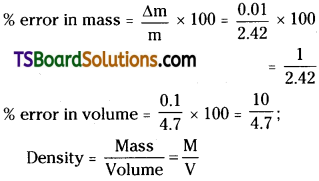
Maximum % error in density = % error in mass + % error in volume Maximum percentage error in density
= \(\frac{1}{2.42}+\frac{10}{4.7}\) = 0.413 + 2.127 = 2.54%
Question 8.
The error in measurement of radius of a sphere is 1%. What is the error in the measurement of volume? [AP Mar. ’19]
Solution:
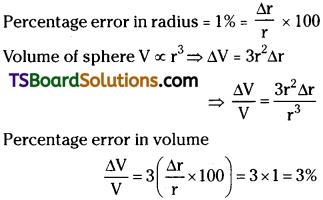
Question 9.
The percentage error in the mass and speed are 2% and 3% respectively. What is the maximum error in kinetic energy calculated using these quantities?
Solution:
Percentage change in mass = \(\frac{\Delta \mathrm{m}}{\mathrm{m}}\) × 100 = 2%
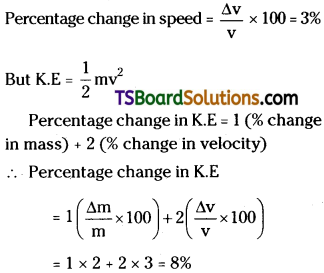

Question 10.
One mole of an ideal gas at standard temperature and pressure occupies 22.4 L (molar volume). If the size of the hydrogen molecule is about 1Å, what is the ratio of molar volume to the atomic volume of a mole of hydrogen?
Solution:
Size of Hydrogen atom ≈ 1Å = 10-10 m = 10-8cm
V1 = Atomic volume = number of atoms × volume of atom.
One mole gas contains n’ molecules.
Avogadro Number, n = 6.022 × 1023
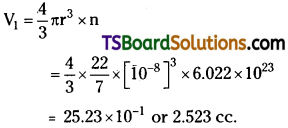
V2 = Molar volume of 1 mol. gas = 22.4 lit
= 2.24 × 104C.C
∵ 1 lit = 1000 c.c.
∴ Ratio of molar volume to atomic volume = V2 : V1
= 2.24 × 104 : 2.523 ≅ 104 m.
![]()
![]()
















